Brightspace Learning Environment
Assignments – Save time by copying assignments to other courses | Updated
Instructors who teach multiple courses can now copy assignments to other courses. To copy assignments, instructors first require the Assignments > Copy to Other Courses permission on both the originating and destination courses.
The new Save and Copy button replaces the old Save button in the Assignment dialog. If users want to adjust the text to reflect their workflow, they can change the name of the Save and Copy button to their preferred term.
Note: The Save and Copy button only appears when creating a new folder. It does not appear when editing an existing folder.
Instructors can copy assignments in two ways:
-
Using the Assignments tool to select an existing assignment
-
Using the New Content Experience (Lessons) tool
Each of these methods enables instructors to copy the following assignment attributes to the new destination:
-
Assignment folder and its properties, including instructions, assignment category, and visibility
-
Assignment properties, including description and category
-
Attachments (direct file attachments, uploaded from Google Workspace or OneDrive, and audio and video files)
-
Grade item and grade category
-
Availability dates
-
Submission and completion information, including the Optional Grade item and the course scheme
-
Rubric(s) associated with the assignment
Note: When copying an assignment that uses a shared rubric, instead of linking a copied assignment to a shared rubric, the rubric is also copied. The copied assignment links to the copied rubric. If an assignment uses a rubric that is archived, the rubric is copied and retains its archived state in the destination course.
The following attributes are not copied to the new assignment destination:
-
Instruction Quicklinks and attachment resources created with the Attach link to existing activity action
-
Instruction images added using Insert Stuff that were saved to course files
-
Availability release conditions and special access settings
-
Submission and completion information including group assignment designation
-
Evaluation and Feedback information, including Turnitin associations, competency, and outcome associations
-
Content topic associations (for example, if the assignment is linked from content)
Note: In some cases, references to links and images that are not copied may result in broken links.
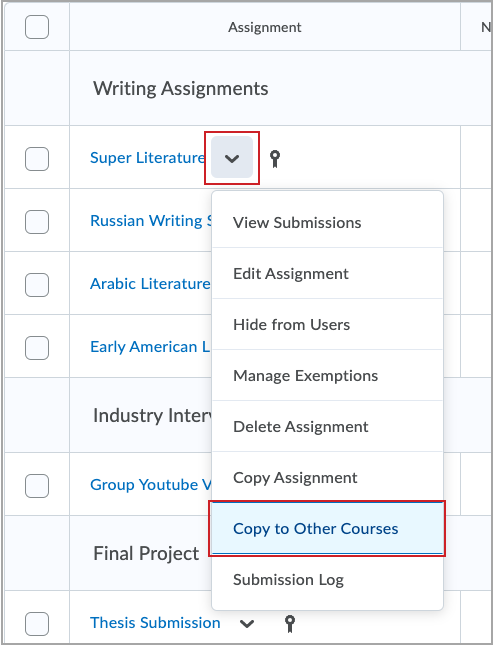
Figure: The Copy to Other Courses menu option in Assignments.
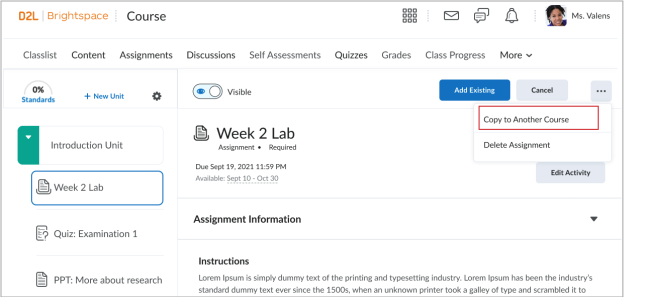
Figure: The Copy to Another Course menu option in New Content Experience (Lessons).
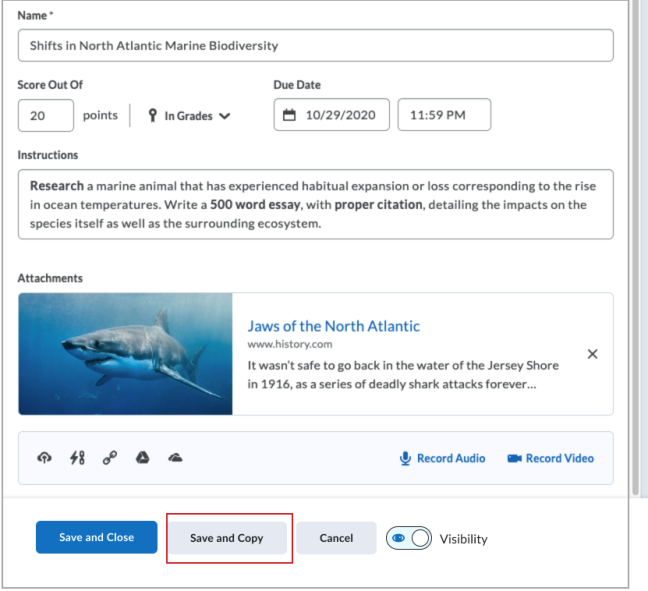
Figure: The Save and Copy option in Assignments that opens the Copy Assignment dialog, which replaces the old Save option.
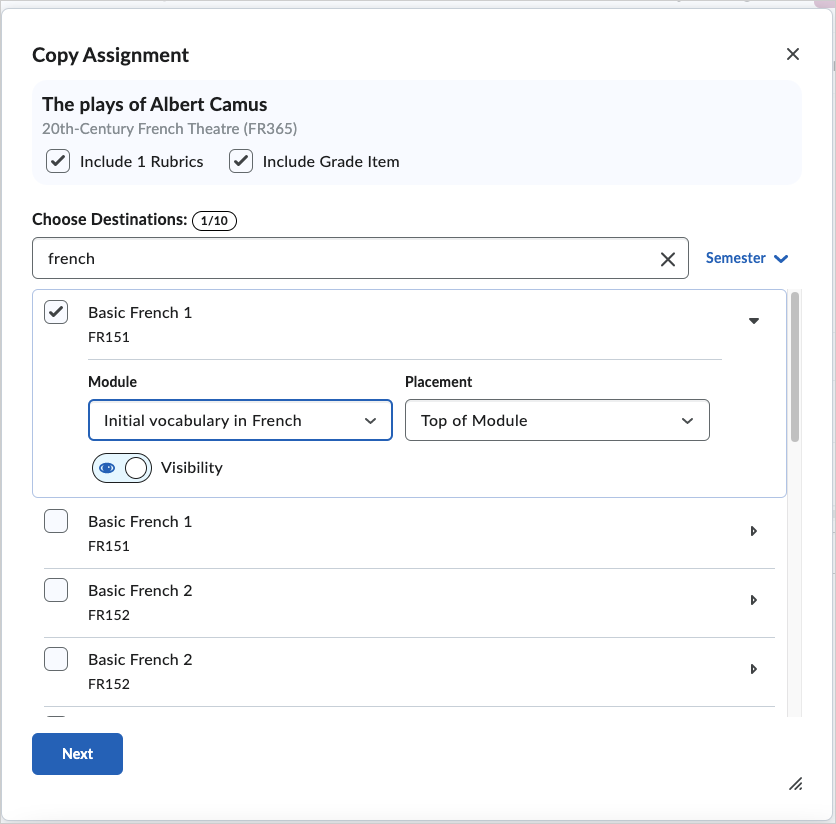
Figure: Copy Assignment dialog showing course destinations.
Technical Details
Impact:
- Moderate impact to instructors who can now copy assignments from one course to another.
Availability:
- This feature is available to all clients.
To enable:
If using the Assignments > Copy to Other Courses workflow:
-
This functionality is automatically enabled and is set to On by default.
If copying from the New Content Experience (Lessons):
-
This functionality is automatically enabled and is set to On by default.
If Save and Copy is optionally enabled by your administrator:
-
This functionality is enabled by your administrator with the configuration variable d2l.Tools.Dropbox.AllowSaveandCopy and is set to Off by default.
Brightspace Pulse – Retirement of the + button for manual dates in Work To Do | Removed
The + button for adding manual dates in the work to do page is no longer available to learners. Previously, learners could use the + button to add personal due dates for activities. Now, only activities that come through Brightspace are viewable. All users who use this feature were notified a maximum of 90 days in advance each time they interacted with the manual dates, or+, button.
Technical Details
Impact:
- Slight impact to learners who can no longer create manual dates for themselves in the work to do page.
Availability:
- This feature is available to all clients.
To enable:
- This functionality is automatically enabled for all learners.
Classlist - Easily access and view sections for specific users | New
Instructors can now use the Classlist tool to view groups and sections. Previously, instructors could only view section enrollments using various filtering and sorting work flows or by searching within the Sections tool.
A new Classlist tool permission View Section Enrollments can be used alongside the existing View Group Enrollments permission to allow for both sections and groups to be displayed in the Classlist context menu. If a role has only one of the two permissions enabled, then users may only see either View group enrollments or View section enrollments in the Classlist context menu.
This feature implements the PIE Item D8562 (view section enrollment).
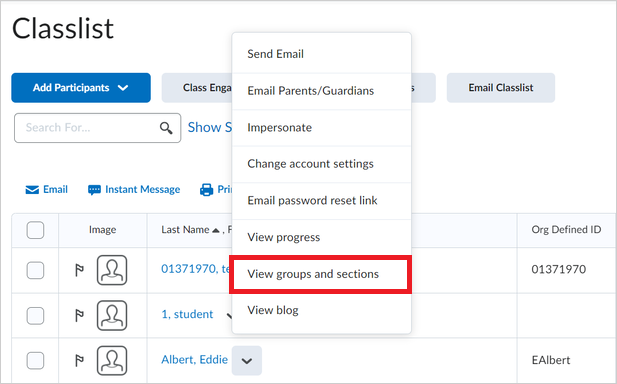
Figure: View groups and sections using the Classlist tool.
Technical Details
Impact:
- Slight impact to instructors due to the ability to quickly view groups and sections for a specific learner.
Availability:
- This feature is available to all clients.
To enable:
- This functionality is only available if the Instructor role View Permissions are set to View group enrollments and View section enrollments.
- This functionality is only available if the Course Offering Information page has Course has sections enabled.
Google File Picker - Improved search capabilities and multi-select | Updated
To increase the value of the Google File Picker - Seamlessly access files from personal and Workspace Google accounts with a single file picker | Updated feature released in August 2022/20.22.08, the new File Picker now searches all user folders for any file that matches the search terms.
In addition to this update, users can now select multiple files to add (link) or upload to Brightspace.
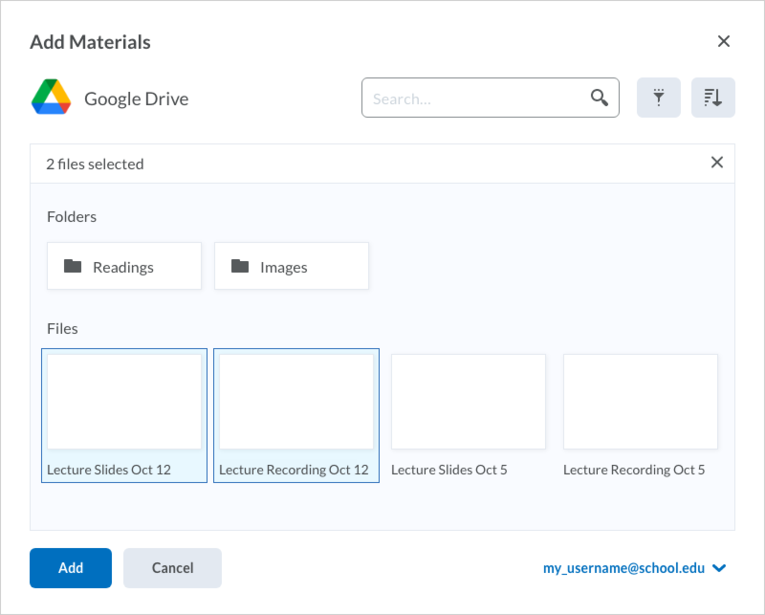
Figure: Selecting multiple files.
Permission updates are applied to all selected files. If using a managed account, file permissions are updated to grant view permissions to anyone in the organization. If using a personal account, file permissions are updated to grant view permissions to anyone with the link. The number of selected files is shown on the 'add' button as a reminder to the user. If multiple files are added to content, each item becomes a separate content item.

Figure: Permissions can be set for all files selected.
Technical Details
Impact:
-
Moderate impact to instructors and learners who can now search multiple folders at once, select multiple files to upload, and set permissions for multiple files at once.
Availability:
- This feature is available to all clients.
To enable:
- This feature is available for anyone who has Google Suite and Google Drive enabled.
Groups/Section Management – Automate asynchronous group creation with Copy Course Components/CCB | Updated
This feature implements group copying via Copy Course Components/CCB so that users can take advantage of the new asynchronous creation method already in use in the Groups tool. Groups copied via Copy Courses workflows create behind the scenes and no longer block further course copy items from completing.
Groups creation status is available in the Groups tool. While the asynchronous creation is in process, instructors see a message indicating that group creation is in progress. The copy history log reports that the group creation process has started. The completion status is notified via an update alert.
Previously, asynchronous Group Creation was implemented in the Groups tool and then automated with APIs.
The asynchronous group creation process in the Group/Section Management tool’s new asynchronous group creation is detailed in the Brightspace Platform April 2022 / 20.22.04 and June 2022 / 20.22.06 Release Notes.
Technical Details
Impact:
- Moderate impact to instructors who use automated workflows due to the ability to create groups as a background task.
Availability:
- This feature is available to all clients.
To enable:
- This functionality is automatically enabled for all users.
Groups/Section Management – View Section Descriptions | New
The Sections API has been updated to include a new mysections API route. This route displays the calling user's sections within a specific orgunitid
and also displays the data for that section including its name, code, and description.
To support this data being provided to users through mysections API calls, the Sections tool includes a new Make section descriptions visible to section members check box under Advanced Properties > Section Options. This new check box that is unselected by default is displayed when creating and
editing sections.
When a learner with the See Sections permission views the Groups tool, their list of groups and sections continue to appear.
If an administrator uses the mysections API route and if an instructor selects the Make section descriptions visible to section members check box, section descriptions appear to learners.
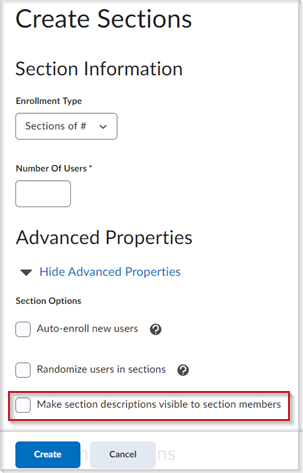
Figure: Create Sections dialog with the new Make section descriptions visible to section members check box.
Technical Details
Impact:
- Slight impact to administrators who use the
mysectionsAPI route due to the ability to display section descriptions to users. - Slight impact to instructors, who can enable the new Make section descriptions visible to section members check box off the Create Sections dialog, which results in section descriptions appearing to learners.
Note: Section descriptions appear to learners only if themysectionsAPI route is called. - Slight impact to learners due to the ability to view section descriptions if enabled by their instructors.
Availability:
- This feature is available to all clients.
To enable:
- When the the
mysectionsAPI route is called, ensure that the Make section descriptions visible to section members check box is selected.
LTI – Legacy LTI (1.1) automatically attempts to migrate to LTI Advantage (1.3) on Course Copy | New
With this release, users can migrate Legacy LTI (1.1) links to LTI Advantage (1.3) links during course copy. This only occurs when an LTI Advantage tool matches the domain of a previous Legacy LTI tool and the LTI Advantage tool has a deployment shared to the destination course prior to copy. If there is no corresponding LTI Advantage tool or deployment, the legacy LTI link continues to function as expected. This functionality is in the LTI Advantage tab in the course. Previously, this link was in External Learning Tool Links.
In addition, users with the Manage LTI Migration permission have access to a Migration Log at both the administration and course level in External Learning Tools. This log tracks all course copies where there are LTI migrations involved and identifies the following:
-
The number of legacy LTI 1.1 links successfully migrated to LTI Advantage
-
The number of legacy LTI 1.1 links that had errors (for example, had a tool, but no deployments)
-
The number of legacy LTI 1.1 links that were ignored (no domain match found)
Users can search and filter the Migration Log results for more detailed information.
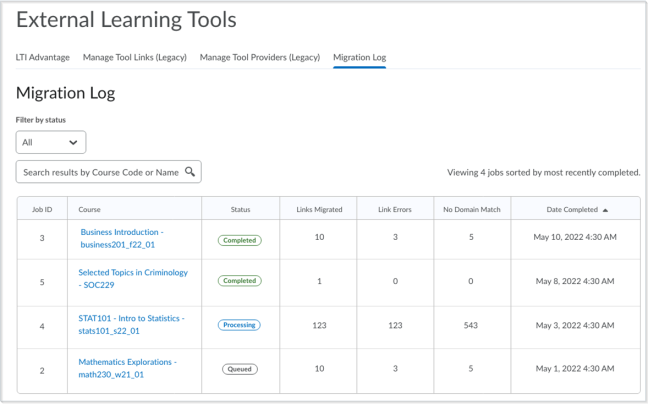
Figure: The Migration Log in External Learning Tools for LTI Migrations showing the table with search and filter options
Finally, interface changes, including changes to tool names, adding the word Legacy to both Manage Tool Links and Manage Tool Providers, and adding a Learn More banner to inform users about LTI migration have been implemented to improve user education around LTI migrations.
Technical Details
Impact:
- Slight impact to administrators and instructors due to the ability to link and migrate LTI Legacy links and tools, as well as the ability to use the Migration Log option.
Availability:
- This feature is available to all clients.
To enable:
- The ability to link and migrate Legacy LTI links and tools is automatically enabled for all users. To enable Migration Log, administrators must enable the Manage LTI Migrations permission for the desired user roles.
Quizzes – Align Quiz questions to Learning Outcomes in New Quiz Creation experience | New
As part of the New Quiz Creation experience, instructors can now view and edit Learning Outcome alignments in relation to quiz questions. Instructors can add or remove Outcome Alignments by selecting a question and then clicking More Actions > Align to Standards. Questions have a visual tag to indicate if they are aligned to outcomes.
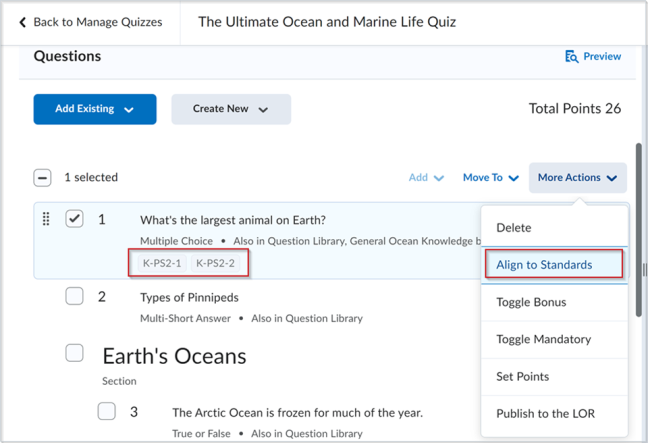
Figure: The Quiz Questions menu with Align to Standards and the outcomes alignment tags highlighted.
Previously, viewing and editing learning Outcome Alignments to quiz questions was not possible in the New Quiz Creation experience.
Technical Details
Impact:
-
Slight impact to instructors due to the ability to view and edit learning Outcome Alignments in relation to quiz questions.
Availability:
-
This feature is available to all clients using the New Quiz Creation experience.
To enable:
-
This functionality is automatically enabled for all users.
Quizzes – Reduce test anxiety by creating quizzes without time limits | New
With this release, instructors have the option to create quizzes with no time limit. The No Time Limit option is now the default Timing setting for new quizzes.
Previously, instructors who wished to create quizzes with no time limit had to use the Recommended Time Limit option, which was selected by default and set to 120 minutes. This led to confusion for learners because the recommended time limit displayed on the quiz itself.
Instructors can create quizzes with no time limit using either the New Experience or the Classic Experience. In New Experience, under Timing & Display, click Manage Timing and select No Time Limit. In Classic Experience, in the Restrictions tab, under Timing, select No Time Limit.
Learners who take a quiz with no time limit now see No time limit under Time Allowed on the Quiz Summary page and Est. Length: No Time Limit on the quiz itself.
This feature implements the following PIE items:
-
D4998 (Quiz: "No Time Limit" option)
-
D3582 (Hide the quiz timing information (Est Length) in the student UI when there is no Enforced Time limit)
-
D4441 (No Time Limit Enforced Reinstated for Quizzes)

Figure: Instructor view of the New Quiz page with the new default No Time Limit option selected.
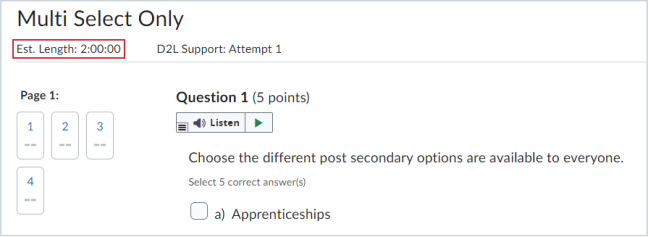
Figure: Learner view of a quiz attempt in progress before this update, displaying the recommended time limit.

Figure: Learner view of a quiz attempt in progress after this update, with no recommended time limit displayed.
Technical Details
Impact:
- Moderate impact to instructors due to the ability to set up a quiz with no time limit.
- Moderate impact to learners due to the ability to take a quiz with no time limit.
Availability:
- This feature is available to all clients.
To enable:
- This functionality is automatically enabled for all users.
Release Conditions – Choose the last date of enrollment in the current org unit | Updated
To help users with more flexibility around course design, the release condition Date of enrollment in current org unit now includes the following options:
-
Use first enrollment date
- Use last enrollment date
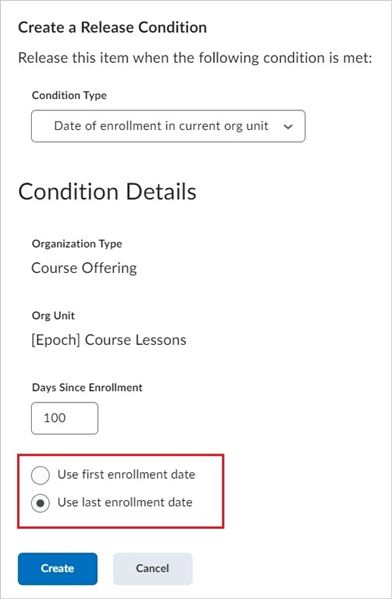
Figure: The Release Conditions menu with the choice of the date of enrollment in the current org unit highlighted.
This feature can also be used to set an intelligent agent; e.g., for learners who have been enrolled more than once in the course, you can decide if the agent applies based on the first time or the last time they were enrolled.
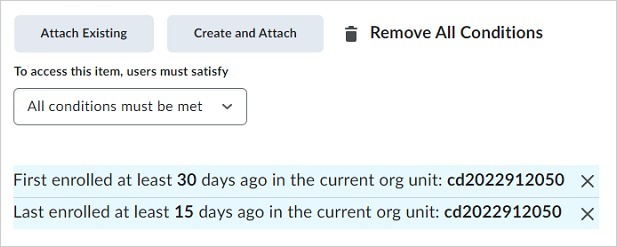
Figure: Intelligent Agent with enrollment date used.
Previously the release condition for Classlist Date of enrollment in current org unit was based on users’ first enrollment into the org unit.
This feature implements the following PIE items:
• D6684 (Reset IA schedule run dates upon reenrollment)
• D8405 (Allow Intelligent Agents to check days based off the latest enrollment date, not the first)
Technical Details
Impact:
- Slight impact to instructors due to the ability to choose the enrollment date in the current org unit release condition is based on either the first or last enrollment.
Availability:
- This feature is available to all clients.
To enable:
- This functionality is automatically enabled for all users.
SCORM – Review/Retake default updated with language and visual improvements | Updated
This feature modernizes SCORM Content Service to bring it in line with users' Content Library by removing the LTI wrapper from the object, and introducing a new native handler for SCORM Objects. Previously, SCORM Objects served to Content via the Content Service were done as an LTI launch.
Additionally, the Review/Retake option for all new SCORM objects now defaults to Do not add review/retake. When this option is set to Add review/retake, it incurs additional performance strain during each SCORM launch; D2L recommends that users should only use Brightspace added Review/Retake options if their SCORM packages do not support this workflow. Previously, the default selection was Add review/retake.
Finally, this feature adds a new Grades Passback method for Content Service Objects. Associated SCORM activity Grade items are labeled as Content Service grade. Any location that displays this information is updated to this grade is associated with the content object <name>. These changes better reflect the location of the SCORM object. Previously, these labels were LTI grade and this grade is associated with the LTI link <name>.
Technical Details
Impact:
-
Slight impact to administrators and instructors due to changes to Review/Retake functionality defaults and language around Content Service objects.
Availability:
-
This feature is available to all clients.
To enable:
- This functionality is automatically enabled for all users.
